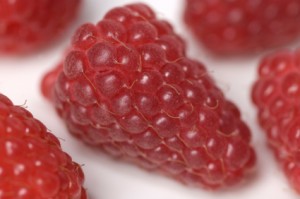Origin
First discovered in the garden of, and named for, James Harvey Logan – a California lawyer who lived 1841 to 1928, the origin of loganberries is a mite controversial. Some believe they are a form of California blackberries, while others believe they are a cross between the American [Aughinburgh] blackberries and the red Antwerp raspberries. Since their origin, loganberries have been used to parent other berries, such as the boysenberry, youngberry, and olallieberry. The original loganberry was first introduced to Europe in 1897. The American thornless, a prickle-free mutation, was developed in 1933.
Properties
 Loganberry plants are among the hardiest around. They are sturdier and more disease and frost resistant than other berries. However, they are not popular with commercial growers as they cost much to harvest. This is due to their thorns and undisciplined growth patterns. The berries hide well and berries of varying maturity can grow from the same plant, which makes them hard to fully harvest at one time. For these reasons they are usually kept in domestic gardens. They can be trained, and when pruned properly, they will produce well for the family gardener. The canes will die off after their second year and should be cut out to keep them from attracting disease. The berries begin green then turn red and finally deep purple when fully ripe. Loganberries make delicious jams, jellies, dessert,s and wines.
Loganberry plants are among the hardiest around. They are sturdier and more disease and frost resistant than other berries. However, they are not popular with commercial growers as they cost much to harvest. This is due to their thorns and undisciplined growth patterns. The berries hide well and berries of varying maturity can grow from the same plant, which makes them hard to fully harvest at one time. For these reasons they are usually kept in domestic gardens. They can be trained, and when pruned properly, they will produce well for the family gardener. The canes will die off after their second year and should be cut out to keep them from attracting disease. The berries begin green then turn red and finally deep purple when fully ripe. Loganberries make delicious jams, jellies, dessert,s and wines.
Planting
Typically loganberries are planted from purchased seedlings or cane cutting, usually from a nursery or another gardening enthusiast who grows them. Plant them in late autumn or early spring to give the best start possible. A location with fertile soil is best, but loganberries are tolerant even when the soil is poor. If amending the soil, do so organically as you would roses, for they are related. The vines tend to behave like their blackberry ancestors, so support them on a trellis to keep them under control, but remember hey aren’t as flexible as blackberries and don’t bend as well. Training them to climb a trellis like climbing roses works better than on wires like your raspberries. To avoid damage to the roots, install the trellis when planting. Space the seedlings (or canes) four to six feet apart. They like an area with full sun that is protected from the wind, as loganberry vines can be very brittle. They don’t stand up well to winds even when they are supported. Loganberries can grow six to eight feet long, so leave room for them without shading nearby plants in the future. If you prefer shorter vines, you can trim them to the desired length later.
Growing
Getting the most of your loganberries will require yearly pruning to remove the older canes and prevent disease. The first year you can leave the plants alone, but start pruning the next year and every year after. After harvesting remove any canes that have produced fruit, cutting them back to ground level. A large bush doesn’t mean more berries, so keeping it down to ten to twelve canes is best for size and good production. Fertilizing and watering is also important. Add fertilizer and mulch each spring and fall. Water well, about an inch weekly and more if it is a dry season.
This isn’t the best way to grow loganberries, but when kept well pruned you can get a decent harvest from pots. Follow the directions for in ground planting, but keep your bushes smaller, with five to six canes instead of ten to twelve, and plant in pots at least two feet across and one foot deep. Give a good dose of organic fertilizer or compost each spring and add a layer of mulch to help retain its moisture.
Diseases and Pests
Generally sturdy and resistant to many pests, loganberries are affected by a few of the problems that can attack raspberries.
Raspberry leaf fungus: These start as small spots of dark green that start spreading to new leaves. These spots grow large and the infected areas will fall out, leaving a hole in the leaf. While a few infected leaves will not cause much harm, a new plant can be totally defoliated if not treated. Spray an infected plant with a natural fungicide when you first see the green spots and remove any of the infected leaves, raking them away from your berry patch. Do not add these leaves to your compost pile but destroy them.
Dryberry: This is specific to loganberries. Tiny mites that live in the buds of your berry canes start feeding on the berries as the fruit develops, leaving berries with dried spots or dead sections in them. Treat the plants with a natural insecticide when the berries start to form to combat the mites.
Harvesting and Storing
Bushes that have been pruned down to ten to twelve canes will each produce ten or more pounds of berries each year. These berries will ripen in late summer as plump deep red or purple berries. Loganberries do not pull free from their core when they are picked, and this can’t be used as a way to tell if they are ripe. They ripen at various times, so plan to pick them several times throughout the summer to get all the berries you can. The picking season usually lasts about two months. Watch for thorns when picking the berries, as they can rip the skin deeply as you harvest. Loganberries have an annoying habit of growing berries under their leaves, so you must poke around the bushes thoroughly to get all of the berries. Wearing long sleeves and gloves will help to protect hands and arms. If thorns are too much hassle, plant a thornless variety—they all taste the same.
Use fresh loganberries quickly, they will only last about five days in the refrigerator. To keep them longer, freeze the loganberries quickly. They will keep up to a year when frozen and can be used in cooked dishes or made into jams, jellies, and pies when thawed.
©2011 Off the Grid News

